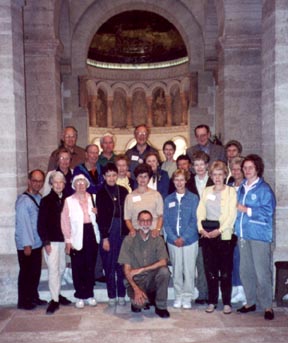 Pilgrimage
Pilgrimage
Paris to Santiago de
Compostela
Written by Dr. Kenneth and Alice Meyer
Photos by Fr. Alexis
and Br. Pierre
September 2000
 Pilgrimage
Pilgrimage
Paris to Santiago de
Compostela
Written by Dr. Kenneth and Alice Meyer
Photos by Fr. Alexis
and Br. Pierre
September 2000
Background: The apostle, St. James, went to Spain to spread the gospel, but returned to Judea where he was beheaded in 44 AD. His body found its way into a boat, perhaps carried by his followers, that was carried over the waves to northwestern Spain where it lay undiscovered until the 9th century. A peasant saw a shower of stars come down on a field (Compostela) that matched the dream of the local bishop. The body was identified, and a church built, and pilgrimages began because miracles were performed. When the moors were being fought, and the Christians losing they prayed to St. James and he came on a great white charger and defeated the moors - hence St. James the Moor slayer. As the pilgrimage grew, becoming the most famous of the middle ages and more important than Rome or Jerusalem, churches and hostels were built about every 30 miles - the day's walk. There were four main routes through France, meeting at Roncesvalles (Roncevaux). The pilgrimage is credited with starting the travel business, and with creating the sense of Europe, as so many people left their isolated towns and villages, and in traveling, met and exchanged views with others. We followed the main route from Paris.
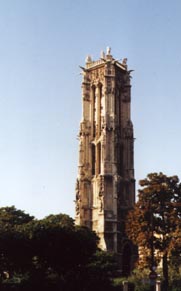 Our
pilgrimage began in Paris, Where we arrived midafternoon on Sunday
September
10th, having arrived on Iberian Airlines after a very
pleasant
flight from New York with good meals, via Barcelona (a four hour
stopover).
In addition to Father Alexis and Brother Pierre of Mount Saviour, our
group
included Diane and Paul Treveiler, the organizers of the trip, and his
brother and sister-in-law, Betty Groth and Barbara Doheny, friends of
moms,
Adele Butler Nash, aunt Sis's best friend, a former head of Corning,
Inc.,
and his two sisters and spouses, a nun from Elmira, and other women,
either
single or sans husbands.- a total of 25. Met by our guide, Yannis -
who,
we learned later in the trip, was born in Tunis of a Jewish father and
Christian mother and had been, because he was not Muslim, considered
French
in Tunis, but Tunisian when he came to France for 9th grade,
and so, despite knowing 5 languages, and being very bright, is now
living
in Italy.
Our
pilgrimage began in Paris, Where we arrived midafternoon on Sunday
September
10th, having arrived on Iberian Airlines after a very
pleasant
flight from New York with good meals, via Barcelona (a four hour
stopover).
In addition to Father Alexis and Brother Pierre of Mount Saviour, our
group
included Diane and Paul Treveiler, the organizers of the trip, and his
brother and sister-in-law, Betty Groth and Barbara Doheny, friends of
moms,
Adele Butler Nash, aunt Sis's best friend, a former head of Corning,
Inc.,
and his two sisters and spouses, a nun from Elmira, and other women,
either
single or sans husbands.- a total of 25. Met by our guide, Yannis -
who,
we learned later in the trip, was born in Tunis of a Jewish father and
Christian mother and had been, because he was not Muslim, considered
French
in Tunis, but Tunisian when he came to France for 9th grade,
and so, despite knowing 5 languages, and being very bright, is now
living
in Italy.
After a bus tour of Paris, through which half of the group slept, we were taken to our hotel, which had been someone's palace but now rather theatrically redone, and after a brief rest, Fr. Alexis and Brother Pierre and Dad went to the Tour St. Jacques, the historical starting point for pilgrims from Paris and then to Notre Dame. The tower is actually the only thing that remains of an early 16th century church and sits in a pleasant park across the Seine from Ile de la Cite and Notre Dame.
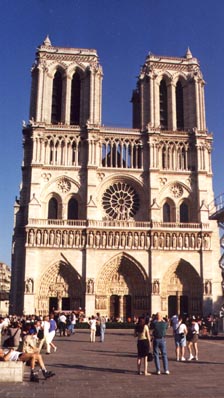 Entering
the square in front of Notre Dame was
the first
of the wonderful surprises of the trip - the church glowed in the clear
afternoon sunlight, the facade having been completely cleaned since we
were last in Paris. The interior however, remains dark. We returned to
the hotel where Fr. Alexis said the first of our daily pilgrim Masses.
These were highlights of the trip as his sermons led us through the
pilgrimage
and were so to the point they almost brought one to tears. On this
first
day he reminded us that pilgrimages were times of prayer and of joy so
that we should have fun. (He took his own advice, giving wonderful
Masses
and enjoying everything and everyone at other times. The Lesson- God is
in everything!) After dinner at a nearby restaurant, a welcome sleep.
Entering
the square in front of Notre Dame was
the first
of the wonderful surprises of the trip - the church glowed in the clear
afternoon sunlight, the facade having been completely cleaned since we
were last in Paris. The interior however, remains dark. We returned to
the hotel where Fr. Alexis said the first of our daily pilgrim Masses.
These were highlights of the trip as his sermons led us through the
pilgrimage
and were so to the point they almost brought one to tears. On this
first
day he reminded us that pilgrimages were times of prayer and of joy so
that we should have fun. (He took his own advice, giving wonderful
Masses
and enjoying everything and everyone at other times. The Lesson- God is
in everything!) After dinner at a nearby restaurant, a welcome sleep.
Monday September 11 In the morning, the bus took us to Montmartre and Sacre Coeur Basilica. We learned that it was constructed after the Franco-Prussian war (which France lost and the occasion for Dad's grandfather coming to the US), through the efforts of some laymen who felt the loss was God's punishment for France's irreligion. Its interior was being renovated but we had Mass in the crypt and then a tour of the old town, which in the 19th century was rural and cheap so where the artists congregated. St. Denis was beheaded on Montmartre and legend has it that he picked up his head, washed it in a spring that still flows, ( and which we visited) and walked several miles to where the church of St. Denis now stands. We could see it in the distance. We saw were Picasso painted "Les Demoiselles d' Avignon" and the church where St. Ignatius, though Spanish, founded the Jesuits. Mom and I took a cab to Maxim's to buy perfume, and then walked to the café of the Louvre where we met Betty and Bill Byron for lunch. She and mom met when mom was working in Paris and she had done a film on the pilgrimage, which we had tried to get but it was out of print. She did give a talk about the pilgrimage to the group at dinner that night.
We expected to rejoin the group in the museum, but missed them so we walked through the streets of Paris, looking for the discount perfume shop, but neither they nor the nearby Chanel shop had Chanel # 19 so we tried another Chanel shop but they had only jewelry. They referred us to another shop that mom said was behind the Ritz hotel and that we could walk through the hotel rather than walking around the square. We got kicked out! In truth we did look like bums. After finally getting the perfume, we walked for a while and then took the metro back to the hotel.
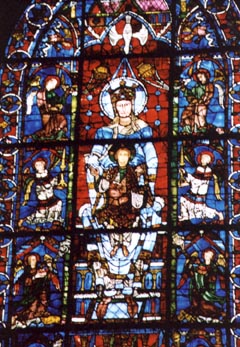 Tuesday
September 12 Up early, we went through dreadful traffic to Chartres,
arriving just in time to dash into the crypt for Mass. The cathedral
crypt
is the foundation of the earlier Romanesque church built on top of a
Celtic
church, built on top of a pagan temple. The area we were in had some of
the remaining original frescos and behind the altar was the Black
Virgin
of Chartres (a reproduction ,as the original was burned in the French
Revolution).
To the side was a beautiful reliquary, obviously of something
important.
We learned later that it contained the ashes of Mary's dress that had
been
one of the great relics of Chartres but was burned in the revolution.
Only
a small portion remains and that is on display in a chapel of the upper
church. We also learned that the reason there are so many Black Virgins
is that they are made of pear wood whose original soft yellow becomes
black
on exposure to air.
Tuesday
September 12 Up early, we went through dreadful traffic to Chartres,
arriving just in time to dash into the crypt for Mass. The cathedral
crypt
is the foundation of the earlier Romanesque church built on top of a
Celtic
church, built on top of a pagan temple. The area we were in had some of
the remaining original frescos and behind the altar was the Black
Virgin
of Chartres (a reproduction ,as the original was burned in the French
Revolution).
To the side was a beautiful reliquary, obviously of something
important.
We learned later that it contained the ashes of Mary's dress that had
been
one of the great relics of Chartres but was burned in the revolution.
Only
a small portion remains and that is on display in a chapel of the upper
church. We also learned that the reason there are so many Black Virgins
is that they are made of pear wood whose original soft yellow becomes
black
on exposure to air.
After Mass, we met our guide - an Indian woman who said at the beginning that she was Hindu and not Christian. She gave an excellent tour. The interior of the Cathedral was another revelation. When I had first seen it ( in 1953), the windows were all a dark blue and the feel was of heavenly darkness. Now the windows have been cleaned and centuries of erosion repaired and they glow with a wonderful clear light, transforming the cathedral into joy, even though we were there on an overcast day. The north rose window had just been reinstalled two weeks before. Our guide showed us the chapel with what remains of Mary's dress, which originally was the same shape and size of a modern sari. She explained the stories in some of the windows and the portals and told us that the floor was sloped because the pilgrims stayed in the church with their animals and that there was a great cistern that collected water from the roof that was then released to let the straw and etc. flow out the main doors.
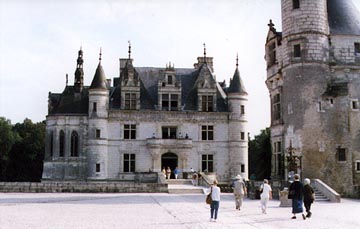 We
ate lunch sitting on the south porch of the cathedral and then on the
bus
to a brief view of Blois and then a tour of Chenonceau,
a chateau that spans the Cher, a tributary of the Loire. It is small
enough
to appreciate, has lovely gardens, and each room had an unusual
arraignment
of flowers. In the kitchen was a long low bowl filled with green gourds
and ivy with a white edge. Stunning. On to the center of Tours for the
night. Mom and I ate in a bistro, she had a French steak and I,
mussels.
We
ate lunch sitting on the south porch of the cathedral and then on the
bus
to a brief view of Blois and then a tour of Chenonceau,
a chateau that spans the Cher, a tributary of the Loire. It is small
enough
to appreciate, has lovely gardens, and each room had an unusual
arraignment
of flowers. In the kitchen was a long low bowl filled with green gourds
and ivy with a white edge. Stunning. On to the center of Tours for the
night. Mom and I ate in a bistro, she had a French steak and I,
mussels.
Wednesday September 13. Following the Loire, we had Mass in Germigny-des-Pres, in Loriet. It is the oldest church in France, constructed in 806 by Charlemagne. Beautifully simple, with light coming in through clerestory windows in the dome; and in the apse, a 9th century golden mosaic of angels bringing the law to the world (Charlemagne's great endeavor). The mosaic was only uncovered in the late 19th century when some kids threw stones and some of the plaster covering, placed to protect its gold from the raids of the Vikings, fell off revealing the mosaic hidden for a thousand years. We stood around the altar for Mass and Fr. Alexis, who is tall and thin, looked like a picture of a medieval priest.
On to St. Benoit-sur-Loire, again following the road along the river. The first monastery was founded in 630, and in the 8th century the monks brought, through "holy theft" the relics of Saint Benedict from Monte Cassino because the monks there had fled before the Lombards (and the local monks wanted a reason for pilgrims to come to them and leave their alms). They now are in the crypt of the now extant late 11th century church. Its oldest part is a tower, built to watch for marauding Vikings. It is astounding to realize that the Vikings came so far up the river without anyone stopping their advance or retreat. They must have truly intimidated the people or the people along the Loire so fragmented that they could not organize a coordinated defense . It certainly was a violent time, but one in which the church was a stabilizing force. The tower has twelve arches at is base, representing the twelve gates of heaven described in St. John . Within, in the left transept, is a beautiful 14th century Madonna and Child and in the crypt, the reliquary of St. Benedict - a rectangular box with a peaked roof top, a design which we were to see repeatedly on the trip. The basic design is an ancient Roman one for a tomb. The monk who showed us around said that in the middle ages, the relics were so precious and the danger of their being stolen (pious return) so great that pilgrims were not allowed into the crypt and that a wall with windows, which still exists, was built to allow them to venerate the relics without fear of their loss. The floor of the apse, in front of the main altar was of tiles of Roman marble and semiprecious stone from the 4th to 6th century, taken after the sacking of Rome. In the middle ages, having a great relic was important because the end of the world was expected soon and the belief was that if you were near the bones of a great saint, you would be brought to Heaven along with the saint, no matter how bad you were.
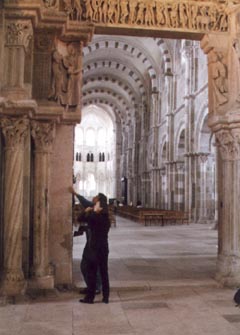 On
to Vezelay and the church of St. Mary
Magdalen,
the most beautiful and spiritually inspiring church I have ever seen.
Its
exterior, reconstructed after damage during the French revolution
(until
this trip I had no idea of the anger against the church in the French
revolution
- it was like Pol Pot of Cambodia against the educated) gives no clue
to
its interior. One enters a great double cubed enclosed porch, with a
gallery
above from which the priests harangued the pilgrims and heard their
confessions
before they were allowed into the main body of the church. There is a
tympanum
over the great wooden doors, of Christ in Glory and the last judgment;
the garments of the elect are blowing in the wind of the Holy Spirit.
Below
is the spreading of the gospel to the ends of the earth, including to
the
Africans whose ears were so big that they used them as blankets for
sleeping.
On
to Vezelay and the church of St. Mary
Magdalen,
the most beautiful and spiritually inspiring church I have ever seen.
Its
exterior, reconstructed after damage during the French revolution
(until
this trip I had no idea of the anger against the church in the French
revolution
- it was like Pol Pot of Cambodia against the educated) gives no clue
to
its interior. One enters a great double cubed enclosed porch, with a
gallery
above from which the priests harangued the pilgrims and heard their
confessions
before they were allowed into the main body of the church. There is a
tympanum
over the great wooden doors, of Christ in Glory and the last judgment;
the garments of the elect are blowing in the wind of the Holy Spirit.
Below
is the spreading of the gospel to the ends of the earth, including to
the
Africans whose ears were so big that they used them as blankets for
sleeping.
Within is a soaring Romanesque nave, whose columns began to bend inward so the outer aisles were constructed for support - in later construction these became the flying buttresses. The apse is early gothic. The entire effect, partly because of the inward bowing and partly because of the gothic apse, is intensely uplifting. The inner portal still has remnants of the original bright painting which must also have adorned the famous capitals depicting scenes of the old and new testament. In the crypt there is a chapel to the Blessed Sacrament and t and opposite, the reliquary of the bones of St. Mary Magdalen in an ark-like, glass enclosed reliquary. The monastery that was next to the church was destroyed, again in the French revolution, but there is a great view of the countryside. The town retains its ancient character and we bought wine and cheese for cocktails.
We spent the night in Avallon, at the Hotel de la Poste, where Napoleon stayed on his return from Elba. A great place, and we had a private patio, and a sitting area. Unfortunately Mom became ill and could not enjoy the great dinner and we had to stay over for an extra day. It couldn't have been at a better place, as the people were great and Yannis gave us his cell phone numbers to catch up the following day. In the afternoon, while mom slept, I wandered around the old town and into their museum, on the top floor of which was a display of the history of St. Martin of Tours (the patron saint of the prior of Mount Saviour) including the pilgrimage route to Tours.
Totally unexpected were the complete Miserere series by Georges Rouault. These black and white lithographs were done by him in 1929 and only printed in 1940. These intensely powerful prints must have been his reaction to WW I and released by that Jewish artist as a response to WW II. The 52 prints are the passion of Christ, each episode of which is reflected in the different sufferings of ordinary humans that themselves reflect the particular stage of His passion. They are deeply moving powerful and expressive . I had seen the crucifixion, and we have one of his lithographs, Veronica's Veil, that was sold to me as being as part of the series, but is not because it is in four colors, and the Miserere series is only black and white. The most compelling for me were a paired Madonna of the Seven sorrows and a suffering mother. When I saw them, the Madonna was immediately recognizable as such, and the suffering mother, in the same pose, was Everywoman. It is astounding how an artist with one or two strokes could convey such spiritual meaning and to reflect, in the human, the divine. I could have ripped them from the walls. It was worth missing Beaune, Tournus and Le Puy-en-Velay.
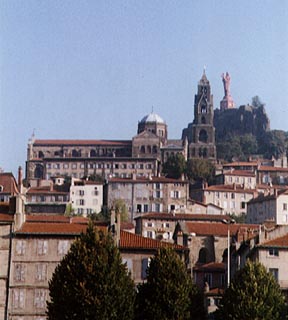 Mom
was better the next day, but the only way to go by train to meet the
group
in Le Puy was to go back to Paris at
6:30 AM
and then have three changes to Le Puy. Luckily I had brought my drivers
license, but the agency that had an outlet in Le Puy had no cars, so we
arranged to get a car to St. Etienne and then a train to LePuy. We went
on the expressway to Lyons at 100 mph - my kind of driving- and turned
in the car only to discover that the train was not running because the
workers were on strike because one of them had been attacked on a train
the day before. If we had tried to go by train all the way we would
have
been stranded. There was a substitute bus, and mom heard a woman say
that
there would only be so many seats and that if we did not get on quickly
where was no way to get another. Mom got on while I put our luggage
underneath
and saved a seat. At the first stop, 12 waiting did not. We called
Yannis
and he met us at the bus station and we went to dinner with the group.
The town was having their annual fete celebrating a medieval event,
with
many in costume - rather like a New Orleans Mardi Gras except the
celebrants
were all in the same kind of costume. After dinner Betty Groth, mom's
friend,
had me run up to see the cathedral, lit by floodlights. They had had an
extraordinary Mass in a beautiful chapel there, which we missed.
Mom
was better the next day, but the only way to go by train to meet the
group
in Le Puy was to go back to Paris at
6:30 AM
and then have three changes to Le Puy. Luckily I had brought my drivers
license, but the agency that had an outlet in Le Puy had no cars, so we
arranged to get a car to St. Etienne and then a train to LePuy. We went
on the expressway to Lyons at 100 mph - my kind of driving- and turned
in the car only to discover that the train was not running because the
workers were on strike because one of them had been attacked on a train
the day before. If we had tried to go by train all the way we would
have
been stranded. There was a substitute bus, and mom heard a woman say
that
there would only be so many seats and that if we did not get on quickly
where was no way to get another. Mom got on while I put our luggage
underneath
and saved a seat. At the first stop, 12 waiting did not. We called
Yannis
and he met us at the bus station and we went to dinner with the group.
The town was having their annual fete celebrating a medieval event,
with
many in costume - rather like a New Orleans Mardi Gras except the
celebrants
were all in the same kind of costume. After dinner Betty Groth, mom's
friend,
had me run up to see the cathedral, lit by floodlights. They had had an
extraordinary Mass in a beautiful chapel there, which we missed.
Saturday September 16. Le Puy is in a volcanic area and from there on we entered hills leading towards the Pyrenees - up to then, we had gone through fertile plains. Delayed by construction, we got to Conques just in time to get into the treasury of the church of Ste. Foy, the greatest collection of medieval art in France. (part of the group, who had dawdled, did not make it as it closed for the afternoon) Ste. Foy was a 12 year old girl who had become Christian against her parents wishes and they turned her over to the authorities. She was martyred in the persecution of Diocletian in the 4th century. Her haunting reliquary with raised head and great, staring eyes, is said to be Egyptian from the 6th century. She is seated and her gold clothing is cased with gems and roman and Byzantine intaglios. In her back is a crystal oval engraved with the crucifixion The other treasures include gifts from Charlemagne and other kings. It is very difficult to comprehend the reverence for relics that led to giving of such precious gifts, irreplaceable treasures gained through the sacking of Rome or other remnants of their empire . The medievals saw the world and religion in a different light. The reliquary of Ste. Foy, however, haunts me.
The church is a Romanesque masterpiece and its great portal still has its original paint, though much faded. One realizes that these churches were once great bursts of color, (and much like going to the circus) not the grey we see today. Unfortunately, there was a confusion in our Mass schedule and a German group beat us out, so we did not have Mass.
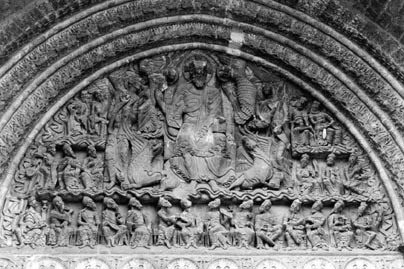 On
to Moissac and the Abbey of St. Pierre
with
its cloisters that were saved by Prosper Merimée in the 19th
century (the railroad wanted to go straight through). The paint in the
church interior did not fade and was restored about 30 years ago. The
pattern
is an interlocking yellow orange tile with blue-grey border and red
central
design. Quite garish when first seen. To accommodate the new liturgy,
the
altar has been moved to one side of the middle of the nave, with pews
on
three sides. In the transept, there is a 16th century
painted
wood, multi-figured, scene of the deposition of Christ.
On
to Moissac and the Abbey of St. Pierre
with
its cloisters that were saved by Prosper Merimée in the 19th
century (the railroad wanted to go straight through). The paint in the
church interior did not fade and was restored about 30 years ago. The
pattern
is an interlocking yellow orange tile with blue-grey border and red
central
design. Quite garish when first seen. To accommodate the new liturgy,
the
altar has been moved to one side of the middle of the nave, with pews
on
three sides. In the transept, there is a 16th century
painted
wood, multi-figured, scene of the deposition of Christ.
We spent the night in a restored Chateau near Moissac, now a hotel. There was a wedding reception, and the seating chart displayed each family's coat of arms as well as their names, to indicate where they were to sit. Not quite the US.